- Category
- War in Ukraine
The Most Lethal Missiles Russia Uses Against Ukraine’s Civilians
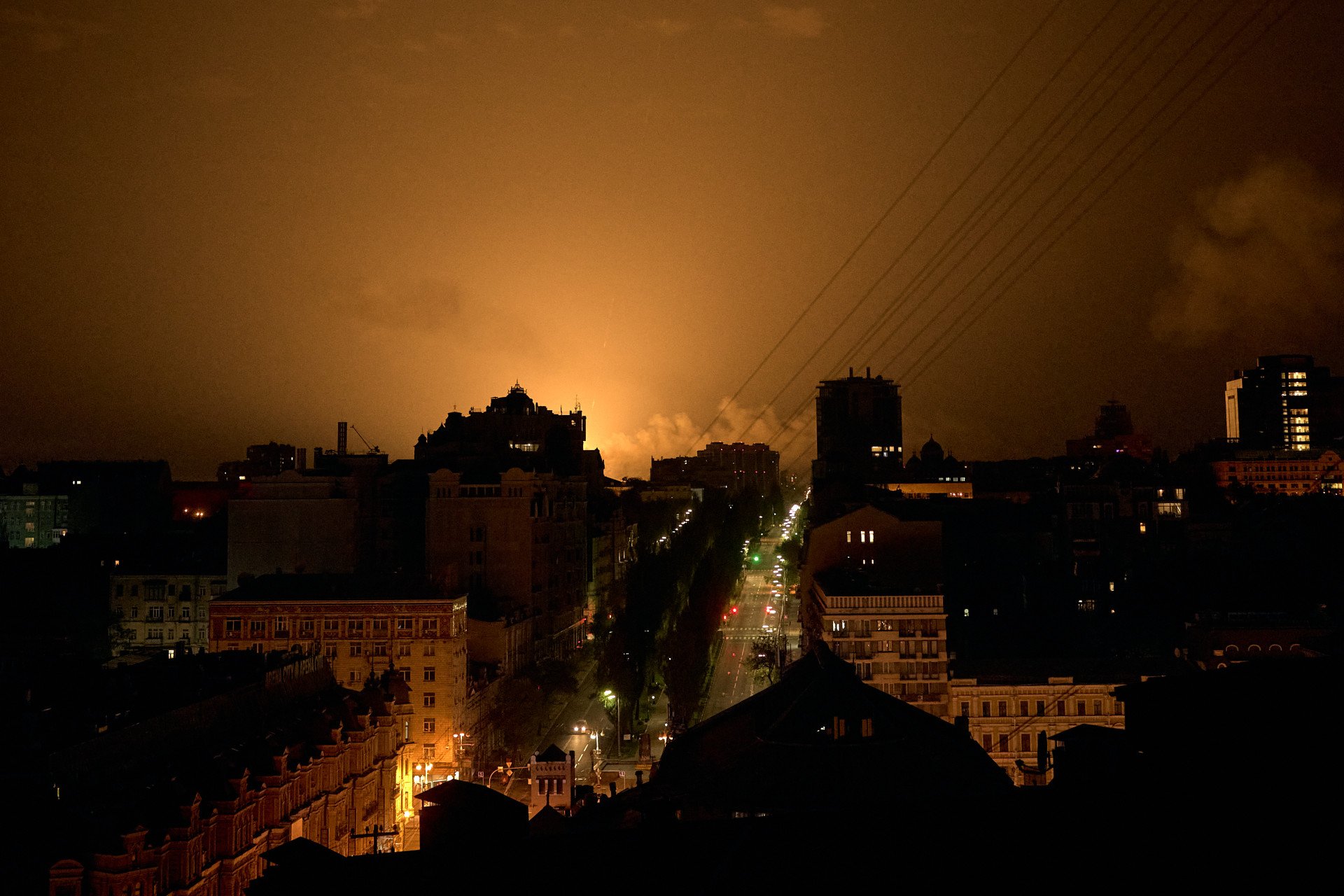
For more than three years, Russia has relentlessly targeted Ukraine’s civilian population with missile strikes, and this year alone, Ukraine has endured some of the most lethal attacks. Which missiles is Russia using to claim the lives of innocent Ukrainian civilians?
Russia launched a large-scale missile and drone attack across Ukraine in the early hours of April 24, 2025.
9 people have so far been confirmed killed in Kyiv, the death toll is expected to rise. “Currently, 31 people, including 5 children, are hospitalized in Kyiv. In total, 70 people were injured in the night attack.” Mayor Vitali Klitschko confirmed.
The Ukrainian capital was targeted with approximately 6 Iskander-M/KN-23 ballistic missiles, around 6 3M14 Kalibr cruise missiles, and numerous drones.
Ukraine’s State Emergency Services DSNS is still working to clear the rubble of destroyed residential buildings in Kyiv.
“Phone calls can be heard from under the ruins - the search will continue until they are sure that they have found everyone. There is information about two children who still cannot be found at the scene,” DSNS reported on Telegram.
Kyiv, Zhytomyr, Dnipro, Kharkiv, Poltava, Khmelnytsky, Sumy, and Zaporizhzhia regions were all under a massive combined Russian attack.
In the Zhytomyr region, Russian forces launched a double-tap strike on rescue workers who rushed to attend the scene, One rescue worker was injured, DSNS confirmed.
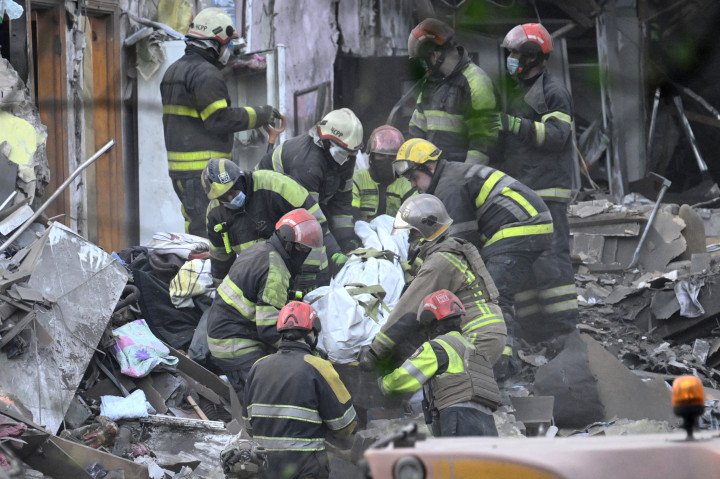
Ukraine agreed to a full 30-day ceasefire on March 11, but Russia has continued to launch deadly missiles indiscriminately at Ukraine’s civilians, killing 618 children and injuring 1,884 since the start of its full-scale invasion.
Since the beginning of full-scale invasion to December 2024, Russia has killed over 12,340 civilians and injured more than 27,836, according to the Office of the United Nations High Commissioner for Human Rights (OHCHR)--figures are undoubtedly higher today.
A total of 42% of Ukrainian casualties resulted from the use of long-range missiles launched by Russia, the OHCHR recorded in November 2024.
Russia launched 11,466 missiles—an average of 23.2 per day—from September 2022 to September 2024
On at least 17 occasions, more than 82 missiles were fired in a single day, according to the Center for Strategic and International Studies (CSIS). On average, Ukraine has successfully intercepted 83.5% of Russian missiles launched, highlighting the nation's success in its air defense programs.
Russia’s missile capacity has been bolstered by North Korean-made munitions, which now make up 75–100% of missiles used in some Russian units.
While precise figures for 2025 are not readily unavailable, recent significant strikes launched by Russian forces suggest a sustained and intense missile campaign.
Russia employs around 30 different missile systems in its war against Ukraine—ranging from Soviet-era to advanced ballistic, cruise, hypersonic, and anti-ship weapons.
However, the missiles listed below have played the most lethal role in targeting civilian infrastructure—repeatedly used to inflict widespread and deadly harm on Ukraine’s population.
What Soviet-era missiles does Russia use against Ukraine?
Kh-22 supersonic cruise missile
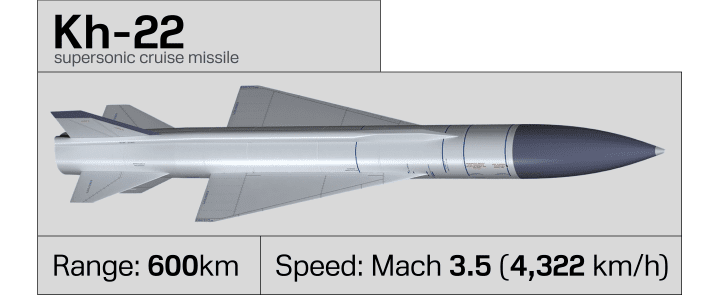
Kh-22 (NATO: AS-4 "Kitchen") is a Soviet-era supersonic cruise missile that has resulted in significant and deadly attacks on civilians in Ukraine. It was originally designed for anti-ship operations but has been repurposed for land-based long-range strikes and fired from Tu-22M long-range bombers.
This missile can carry a highly explosive or nuclear warhead at a range of around 600km. Its blast radius is enormous, and it's capable of completely leveling a building. It travels at high speeds of Mach 3.5 (4,322 km/h), making it difficult to intercept. Compared to modern weaponry, it's notoriously inaccurate—missing targets by as much as 5 kilometers, making it dangerous for civilians to take appropriate precautions.
Russia launched at least 74 Kh-22/33 cruise missiles at Ukraine in 2024. Russia killed at least 46 civilians, injured 79, and left over 400 people homeless after a Kh-22 missile destroyed an apartment building in Dnipro on January 14, 2023.
At the time, Ukraine stressed that its military did not have a defense system capable of downing the missile. In response to the strike, Zelenskyy vowed “to ensure that all Russian murderers, everyone who gives and executes orders on missile terror against our people, face legal sentences. To ensure that they serve their punishment.”
A Russian strike on the Amstor shopping mall, Kremenchuk, in June 2022 killed 21 civilians and injured over 70 people. Russia at the time claimed that their intended target was a Ukrainian arms depot, however, extensive investigations proved that the shopping mall was indeed the target, highlighting Russia’s intent of inflicting high civilian deaths. There have been many more attacks by Russia using this deadly missile.
Dnipro grieves its 46, one year after Russian missile hit an apartment building. pic.twitter.com/9jPhZ5hzid
— UNITED24 Media (@United24media) January 14, 2024
Tochka-U ballistic missile
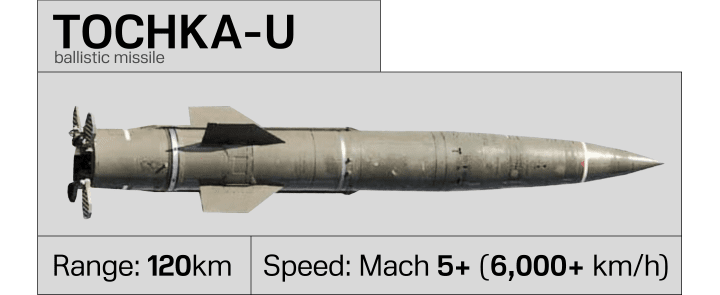
The 9K79-1 Tochka-U (NATO: SS-21 Scarab B) is a Soviet-era short-range ballistic missile with a range of up to 120 km and speeds of up to Mach 5+ (6,000+ km/h). It can be armed with high-explosive, cluster munition, chemical, or nuclear warheads.
A Tochka-U missile carrying a cluster munition warhead struck the Kramatorsk train station on April 8, 2022, killing 61 civilians and injuring 121. The attack has been widely condemned as a war crime.
Since the early stages of the invasion, Russia has largely phased out the Tochka-U in favor of the more advanced Iskander-M missile system.
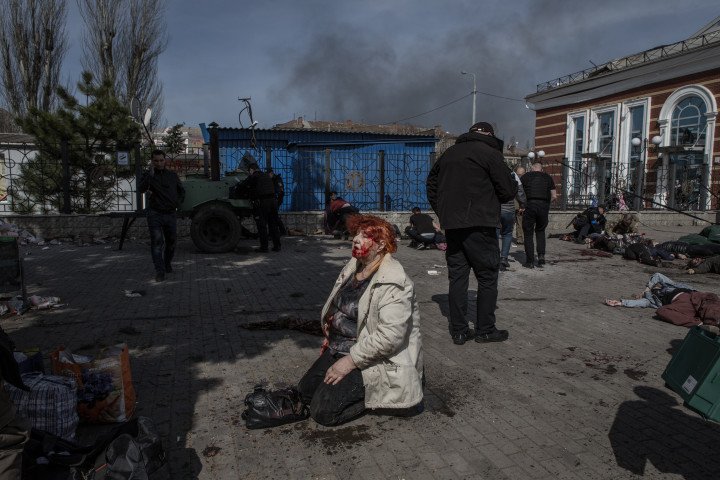
What Post-Soviet missiles is Russia using against Ukraine?
Iskander quasi-ballistic missile
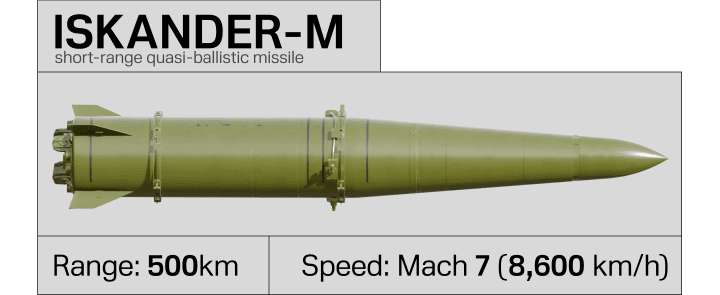
Russia uses different variants of Iskander missiles in Ukraine: Iskander-M (9M723), 9K720 Iskander (NATO SS-26 Stone), and Iskander-K (9M728/9M729), which is also cruise missile capable.
The Iskander-M is the most commonly used variant and is one of the most dangerous ballistic missiles in Russia’s arsenal.
It’s a high-precision, short-range quasi-ballistic missile with a range of up to 500 km. It travels at speeds of up to Mach 7 (8,600 km/h) and can carry both conventional and nuclear-capable warheads. This missile is particularly dangerous because it has a maneuvering warhead, meaning it can shift direction mid-flight to evade missile defense systems.
Its modular design allows for different payloads, including cluster munitions, which release submunitions over a wide area, often resulting in indiscriminate damage and civilian casualties.
In 2024, Russia launched at least 624 Iskander-M ballistic missiles at Ukraine, according to reports.
A Russian double-tap strike using cluster munitions and Iskander-M missiles in Sumy killed 35 people and injured over 100 on April 13, marking one of the deadliest attacks this year. Ukrainian officials confirmed that one of the ballistic missiles used was a North Korean KN-23, a missile closely modeled on the Iskander-M.
-e584b2200c5b473872eef2865d2789f1.jpg)
KN-23 is a North Korean short-range ballistic missile system with a range of up to 500km, known for its maneuverability, high accuracy, and ability to carry either conventional or nuclear warheads.
Kinzhal hypersonic ballistic missile
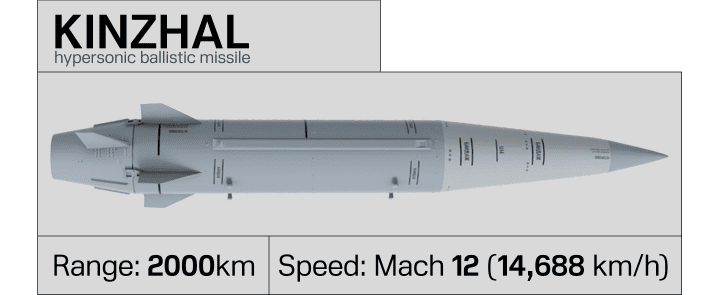
The Kh-47 M2 Kinzhal (NATO name AS-24 ‘Killjoy’) is an air-launched ballistic missile, typically deployed from Russia’s MiG-31K interceptor. Capable of carrying either a conventional or nuclear warhead weighing up to 500 kg, the Kinzhal reaches speeds of up to Mach 12 (14,688 km/h), classifying it as a hypersonic weapon, and has a range of 2,000km.
Moscow has historically praised the Kinzhal missile–also known as the “Dagger"—as one of a series of "invincible" weapons. The missile can fly at an altitude of approximately 20 kilometers, making it challenging, but not impossible, for modern air defense systems to intercept it.
Russia reportedly launched at least 72 Kinzhal missiles at Ukraine in 2024. Despite its speed and maneuverability, Ukrainian air defenses have successfully intercepted several. Notably, in May 2023, Ukraine shot down six Kinzhal missiles of 18 missiles fired by Russia in a single night.
Kalibr subsonic cruise missile
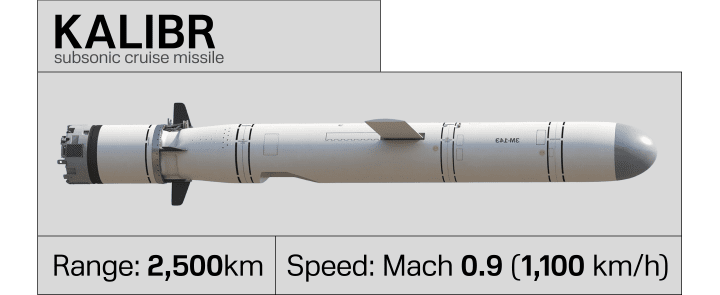
Russia’s Kalibr 3M14 subsonic cruise missile, launched from its Black Sea Fleet, has been a key weapon in repeated winter “blackout” campaigns targeting Ukraine’s energy infrastructure. With a range of up to 2,500 km and travelling at speeds up to Mach 0.9 (980–1,100 km), Kalibr strikes have caused widespread power outages and destruction of civilian infrastructure across the country.
In 2024, Russia fired at least 177 Kalibr missiles at Ukraine. On April 6, 2025, eight were launched from the Black Sea—six were intercepted, highlighting Russia’s continued hostilities despite any ceasefire claims.
Kalibr missiles have been extensively used since the earliest days of Russia’s full-scale invasion. On March 1, 2022, Russia struck the Kharkiv Regional State Administration building with two missiles—the second hitting 10 minutes after the first, as emergency crews responded, marking the start of Russia’s brutal “double-tap” strike tactic.
Kh-101 cruise missile
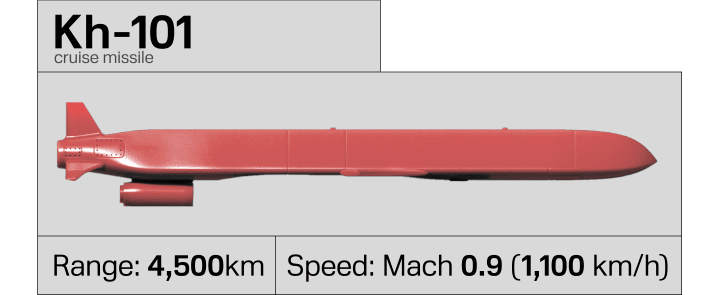
The Kh-101 is a long-range, air-launched cruise missile equipped with a 400 kg high-explosive penetrating warhead. It travels at speeds of up to Mach 0.9 (1,100 km/h). Launched from Tu-95MS and Tu-160 bombers, it has a range of around 4,500 km. It uses terrain-following navigation and flies at low altitude to evade radars, making it difficult to detect and intercept.
Russia fired at least 846 Kh-101 missiles at Ukraine in 2024. Their long reach allows them to be launched from deep inside Russian territory, beyond the range of many Ukrainian air defense systems. Despite this, Ukraine’s air defense systems like Patriot, NASAMS, and IRIS-T have successfully intercepted many.
Russia introduced a modified dual-warhead Kh-101 in January 2024, making it doubly deadly. One such missile, downed by Ukraine in June 2024, carried both fragmentation and cluster munition warheads.
A major strike on March 22, 2024, saw 88 Kh-101 missiles launched in a single day—Ukraine successfully intercepted several.
A Kh-101 struck Kyiv’s Ohmatdyt Children’s Hospital on July 8, 2024, killing two adults and injuring 16, including seven children. Some patients, including some undergoing heart surgery, were undergoing an operation when the missile hit.
Russian forces launched a Kh-101 missile strike against Uman on April 28, 2023, killing 23 civilians and injuring 9, destroying residential buildings and civilian infrastructure.
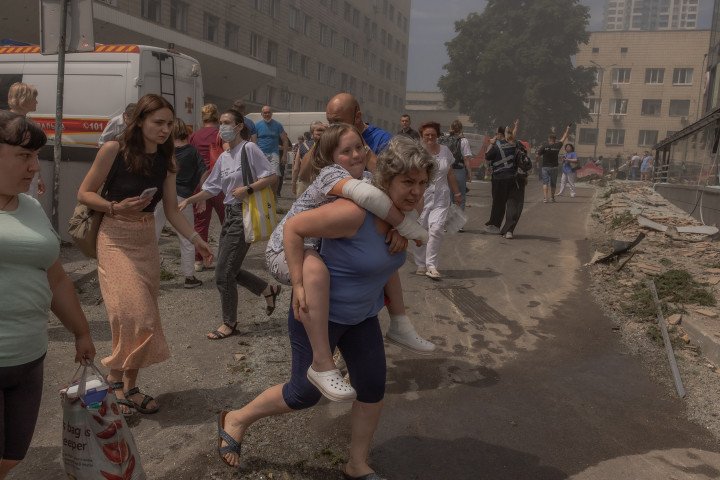
Zircon hypersonic cruise missile
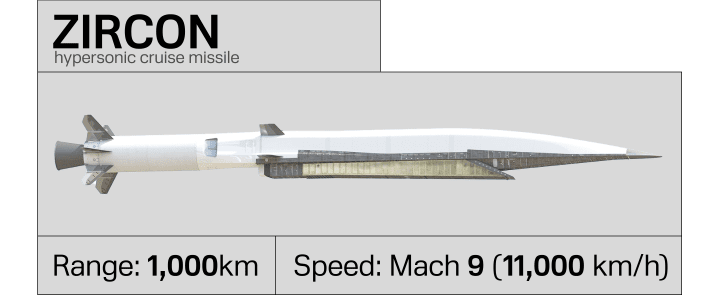
The 3M22 Zircon (Tsirkon) hypersonic cruise missile is designed to carry a high-explosive or nuclear warhead. It has a range exceeding 1000km and travels at high speeds of up to Mach 9 (approximately 11,000 km).
Russia fired at least six hypersonic Zircon missiles into Ukraine in 2024.
Initially designed as an anti-ship missile and launched primarily from naval vessels, the Zircon has also been adapted for land-based launches.
Russia is modernizing and expanding its Pacific Fleet, nearly a dozen new warships—armed with Oniks, Zircon, and Kalibr cruise missiles—are due to launch over the next two years.
The Zircons’ extremely high speeds and maneuverability make it difficult for air defense systems to intercept. Despite Russia’s claim that these missiles are “impossible” to intercept, Ukraine’s forces have successfully downed several.
-46f6afa2f66d31ff3df8ea1a8f5524ec.jpg)
-c42261175cd1ec4a358bec039722d44f.jpg)
-6359eca46c72bde40a90abaaadd6eaa8.png)
-29a1a43aba23f9bb779a1ac8b98d2121.jpeg)

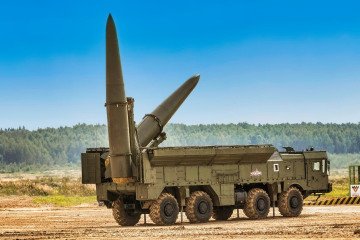
-206008aed5f329e86c52788e3e423f23.jpg)